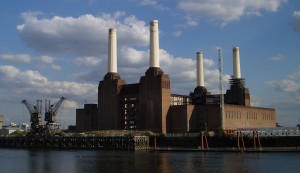A new survey from English Heritage has found that listed industrial buildings are at the highest risk of severe neglect. Around 3% of standard grade I and II* listed buildings in England are considered to be at risk, while a staggering 11% of industrial grade I and II* listed buildings are in the same category.
Grade I and II* industrial listed buildings in England cover a variety of structures from across the industrial spectrum including Battersea Power Station.
According the English Heritage the problem is not a lack of appreciation from the public. A poll of public attitudes carried out on their behalf shows that 86% of the public agree that it is important we value and appreciate industrial heritage and 80% think it is just as important as our castles and country houses.
Despite English Heritage’s obvious concerns about the future of listed industrial heritage sites, it seems that they have some problems categorising the status of some of these sites.
Their 2011 Heritage At Risk Register lists both Battersea Power Station and the Victorian Battersea Pumping Station as “Priority D”. This means “Slow decay; solution agreed but not yet implemented”. Which is ambiguously incorrect on both fronts.
Battersea Pumping station:
The report does correctly state that this historic Victorian Pumping station is going to demolished, despite widespread and authoritative opposition, after a planning application was approved by Wandsworth Council in November 2010. So what English Heritage really mean is, it’s going to be knocked down but it hasn’t been done yet. The pump station is crucial, the only reason to demolish it is it allows the power station owners REO, to maximise profits. Apparently completely ignoring Malcolm Tucker of the Greater London Industrial Archaeology Society who previously made it clear “that it should be possible to incorporate the conserved building within the scheme.”
Battersea Power Station:
Again the report offers clarity by stating “fresh planning and listed building applications approved 2010 subject to legal agreement for restoration, extension and conversion of Power Station to provide retail, residential flats, business, cultural, hotel and conference facilities.”
There are two problems here: 1, “D” has been the status of the power station for decades now and little has changed. 2, the fact that legal agreement is required means that a solution has not been agreed.
Priority D is therefore the developers ideal status. Using the “big bang theory of redevelopment” implementation of the “solution” can be almost permanently postponed. Rather than phased conservation and restoration the heavily indebted REO insists their preposterous scheme to “save” the power station depends of a new tube line being dug, which of course will never happen. They claim that their “solution” to restoration depends on the creation of a whole new urban area- a scheme that looked unlikely even in the height of the property boom.
Meanwhile the building falls into decay and eventually will require demolishing for safety reason giving the developer a clear conscience and nice clear piece of land to build on. Never mind that the nation loses one of its most iconic industrial buildings that are ‘as important as our castles and country homes”.
Of course the developers could “moth ball” both buildings until such time that a genuinely appropriate and viable solution comes along, but there is no need to speculate on why they won’t do that.
Click Battersea Power Station for more blogs
See our Battersea Power Station project pages for more information and videos.
Or visit PlanA our general blog on urbanism, planning and architecture.
Spectacle homepage
Befriend Spectacle.Docs on Facebook
Follow SpectacleMedia on Twitter

